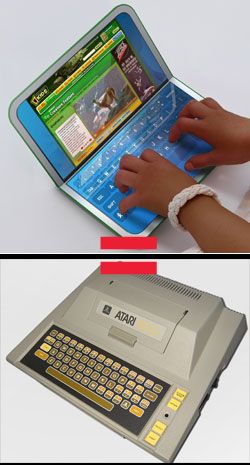XO-2's Virtual Keyboard: Back to the Future?

This week our site has been abuzz with comments about OLPC's next generation laptop, the XO-2. No prototype of the XO-2 has been built yet, and the machines aren't scheduled to ship until 2010, but that hasn't stopped readers from expressing strong opinions about the XO-2's keyboard, or lack thereof.
Replacing a physical keyboard with a touchscreen virtual keypad (à la the iPhone) is a bold move on OLPC's part, but is it good for everyday use?
RoMania commented:
The fact that the keyboard is missing it’s a big problem. Trust me I prefer to type on a real keyboard rather than on a touch screen. [sic]
Flatus said:
Touchscreens that you press may work for an ATM machine, where you’re only doing a few presses while looking at the screen.
A user named Jason was blunt in comparing the XO-2's keyboard to one from the late 70s/early 80s:
Stay in the know with Laptop Mag
Get our in-depth reviews, helpful tips, great deals, and the biggest news stories delivered to your inbox.
The future is typing on an Atari 400?
For those not well-versed in disco-era technology, we should say that the Atari 400 (pictured at right) was an early home PC that featured a membrane keyboard. Membrane keyboards were used in a few other early home computers but were quickly relegated to microwave-oven keypads, because typing on a flat surface is so uncomfortable. Or is it?
Chris Adams, an ergonomics consultant for NASA and About.com's ergonomics Guide, said that a touchscreen keyboard like the one found on the XO-2 is likely to cause more injuries, not because a flat surface is inherently bad but because most users don't have proper typing posture:
Most keyboard operators (as opposed to typists) rest their wrists on the desk or wrist rest (which should only be used during periods of rest, not while typing) and as such have to flex their fingers
upward (past the natural, resting finger posture) on the upstroke. This is bad on your hands. With a touch screen such as this, if you rest your wrist on the laptop (or desk) then your fingertips will rest on the screen or hover just above it. This means you will have no down stroke and only
the bad upstroke. So, if you type with a lazy posture, as most of the users of this type of device probably would, it will be worse than typing on a keyboard with a lazy posture.
When asked about typing accuracy, Adams stated that, while the XO-2 will not be "an ergonomic text entry device," the touchscreen will allow software developers to customize the key sizes and layouts for different users and different applications.
"A touchscreen allows for a lot of customization of controls that can enhance efficiency, even going so far as completely changing control methodology depending on the activity," he said.
So is the XO-2's touchscreen keyboard a taste of the future or a blast from the past? I guess it all depends on whom you ask. To quote one anonymous user, "This is an image of the future. I want one."
